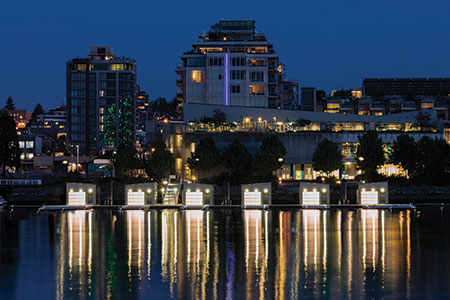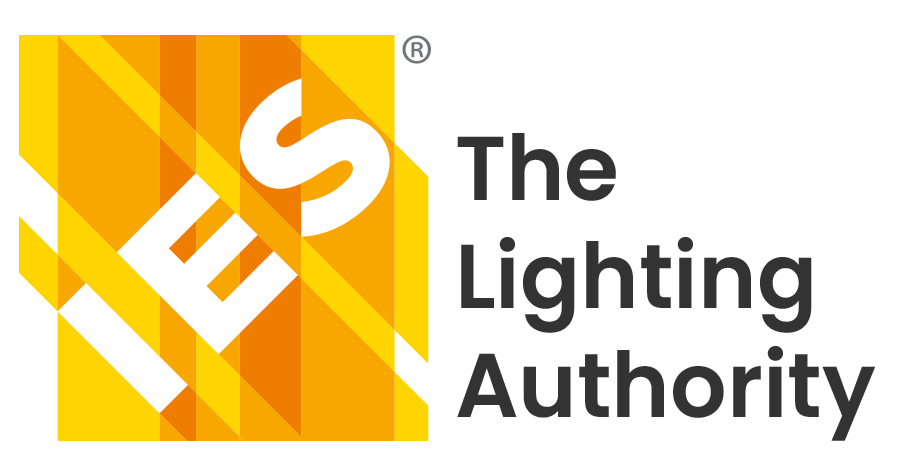By Samantha Schwirck
In Vancouver, a contemporary boating facility recalls the history of dragon racing

Thousands of years before dragon boats were manufactured from lightweight materials like carbon fiber, they were crafted from teak wood and paddled along waterways such as China’s Pearl River Delta. This history was the inspiration for the new False Creek Paddling Centre in Vancouver, British Columbia, where since its April 2016 opening, organizations like the Canadian Dragon Boat Festival Society now store their state-of-the-art fleets.
The center’s six simple, semi-translucent cubeshaped storage buildings and floating docks have a modern aesthetic that fits in alongside contemporary waterfront neighbors like Vancouver’s Science World and BC Place. However, a subtle lighting design causes the sheds to softly glow after dark, conjuring the image of traditional Chinese paper lanterns—a nod to the rich history of dragon-boat racing and the city’s connection to its Asian population.
Lighting consultant WSP/MMM Group worked with McFarland Marceau Architects Ltd. and electrical engineer Moffatt & Nichol on the project, which took about two years, according to former WSP/MMM senior lighting designer Ellie Niakan. While the scope—lighting for the six sheds, docks and gangway—was modest in size, the facility’s location on water posed a specific set of challenges, including material corrosion, exposure to salt water, extreme high and low tides, vandalism, and paddler’s safety at dusk, dawn and darkness.

THE LANTERN EFFECT
WSP/MMM’s first step, Niakan says, was to create “an evenly distributed glowing box with precise luminance imitating the Chinese lantern.” The team considered a few different techniques. “We proved through various mock-ups that wall washing or wall grazing didn’t create the desired effect,” Niakan explains. “The solution was to work with indirect light to illuminate the entire interior space.”
Inside each of the six buildings, two sets of corrosion-resistant wall-mounted linear 3000K LED luminaires (Lumenpulse) throw light toward the ceiling, resulting in reflected ambient illumination. Concealing the luminaires wasn’t a priority, Niakan adds. “The fixtures are mounted on one wall only, but these are very utilitarian spaces, so all of the devices are exposed.” The warm finish of the wood ceiling causes the reflected light to also appear warm in tone, specifically from the outside as it permeates through the sheds’ blue-toned semi-translucent polycarbonate wall panels—the lanterns’ “transparent skin,” Niakan says.
“We specified these luminaires knowing the thickness, density and color of the panels. They are sandwich-type panels with different layers and only the exterior skin is tinted blue—all interior layers are transparent. We did quite a few mock-ups with the panels before specifying the fixtures, specifically in regards to light output and color temperature.” At approximately 400 lumens per ft, the fixtures are bright enough to make the center a visual focal point along the waterfront, but not so bright as to overwhelm the harbor’s harmonious aesthetic or lessen the impact of nearby attractions. “We discussed [color-changing capabilities] and decided not to go with that because Science World and BC Place both have strong color-changing effects at False Creek,” Niakan says. “We didn’t want to compete with those or make the creek too colorful.”
Once the lantern look was achieved, the designers approached the buildings’ functionality. In addition to dragon boats, the sheds are used to store canoes, single kayaks, paddleboards and equipment. Users needed enough light to clearly see the various items, safely retrieve gear, and carry out minor repair work on scratched or damaged surfaces. To that end, four surface-mounted LED luminaires were installed in each shed’s ceiling troughs. “The direct, wide distribution of the luminaires provides enough illuminance without destroying the lantern effect from the outside,” Niakan says.
The 3000K fixtures (Luminaire LED) are corrosion-resistant for marine environments and include an opal polycarbonate lens that “spreads the light evenly, with no lamp imaging on the surface of the fixture and no hot spots on the floors,” Niakan says. “The sheds can be viewed from different angles and elevations—higher elevations on the shore side or lower elevations from the water. Adding to that, the high and low tides change the elevations of the sheds related to viewers. We had to make sure that no hot spots were created by the lights, as they could have been seen through the panels.”
FLEXIBLE FUTURE

light the gangway.
Electrical engineer James Erickson of Moffatt & Nichol was responsible for power systems, controls and the exterior lighting. The two setsof interior luminaires are connected to two preprogrammed astronomical wall switches by WattStopper. One manages the ceiling-mounted fixtures, prompting a work setting at 400 lux for tasks such as equipment retrieval, and the other manages the wall luminaires, prompting a lantern mode that averages 30 lux. Both are regulated by one control panel (Hubbell Lighting) that also includes input from an exterior photocell. The all-LED design meets ASHRAE/IES 90.1-2010 for Storage and Repair Storage/Workshops, with an interior LPD of 5.6 watts per sq meter, or approximately .52 watts per sq ft.
Two additional fixture types were selected to illuminate exterior areas: wall-mounted luminaires with salt-water resistant lenses light the shed doors and gangway (PTLX Global) and inground luminaires (Dabmar Lighting) highlight the attached docks.
With an aesthetic that’s more eye-catching than the typical boat-storage facility, the False Creek Paddling Centre has become a new attraction along the waterfront. “The lighting underlines the location of the sheds, stirs up curiosity and raises awareness about the center to the public,” Niakan says. If the floating lanterns end up drawing even more attention than expected, the team planned for that too—a modular design ensures the facility can be easily expanded to suit future needs.
